Module 11 Body language复习课件17张2021-2022学年外研版英语七年级下册
文档属性
| 名称 | Module 11 Body language复习课件17张2021-2022学年外研版英语七年级下册 | 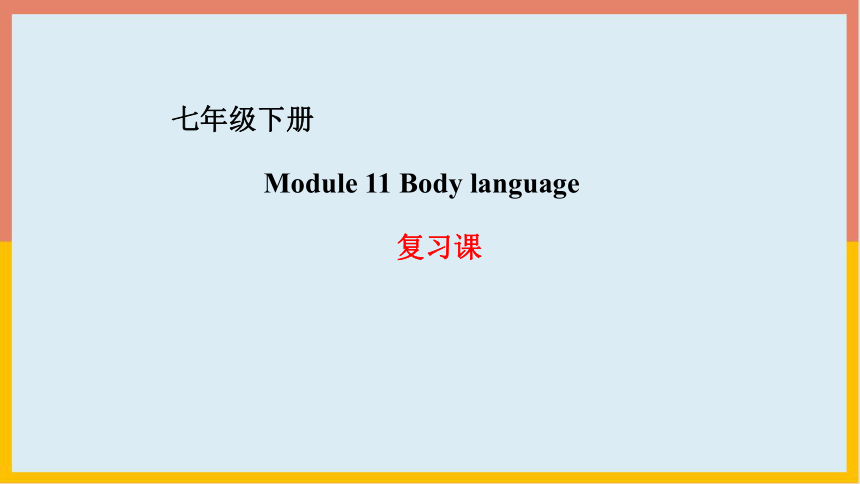 | |
| 格式 | zip | ||
| 文件大小 | 179.0KB | ||
| 资源类型 | 教案 | ||
| 版本资源 | 外研版 | ||
| 科目 | 英语 | ||
| 更新时间 | 2022-01-04 21:54:46 | ||
图片预览

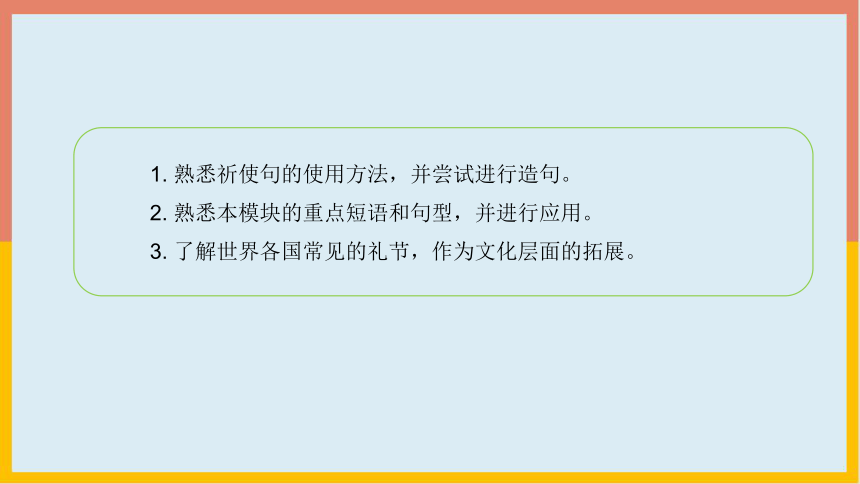
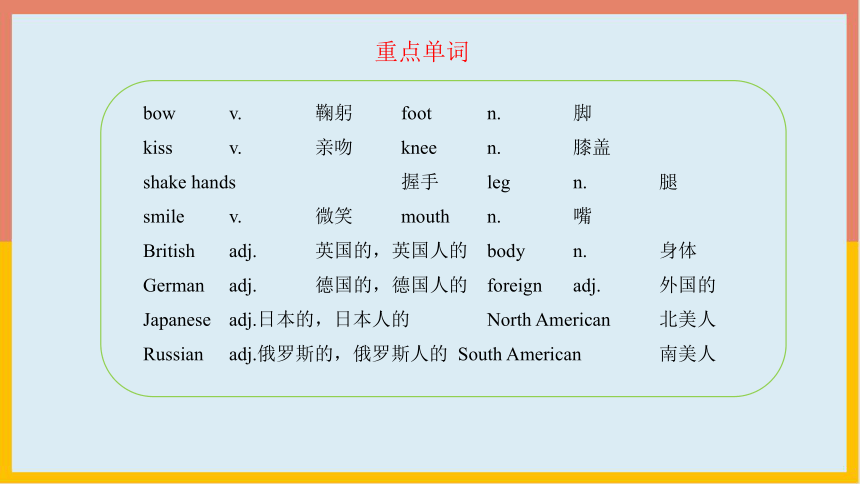
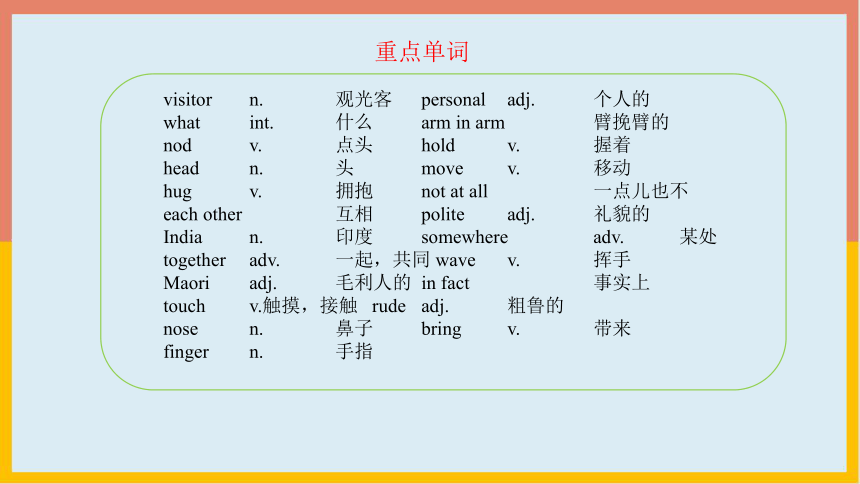
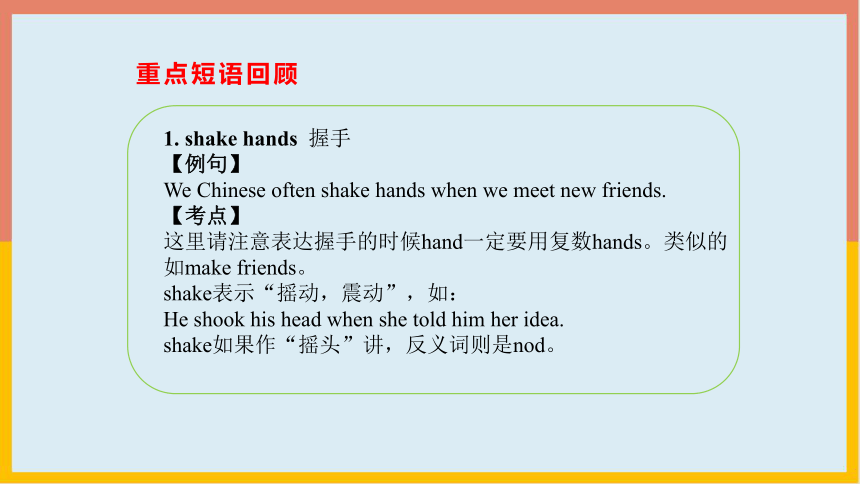
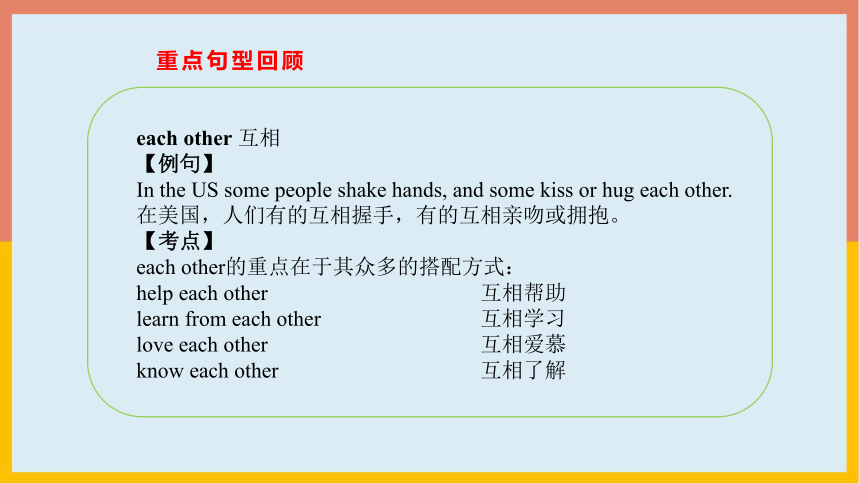
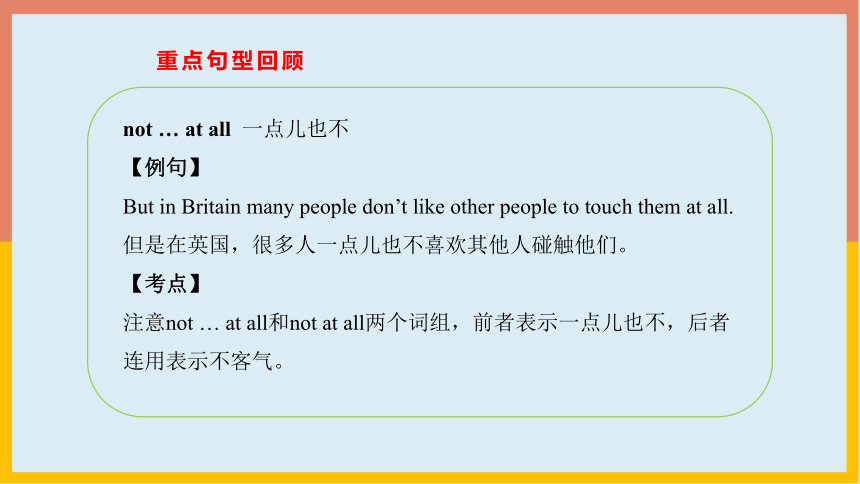
文档简介
(共17张PPT)
Module 11 Body language
复习课
七年级下册
复习目标
1. 熟悉祈使句的使用方法,并尝试进行造句。
2. 熟悉本模块的重点短语和句型,并进行应用。
3. 了解世界各国常见的礼节,作为文化层面的拓展。
知识梳理
bow v. 鞠躬 foot n. 脚
kiss v. 亲吻 knee n. 膝盖
shake hands 握手 leg n. 腿
smile v. 微笑 mouth n. 嘴
British adj. 英国的,英国人的 body n. 身体
German adj. 德国的,德国人的 foreign adj. 外国的
Japanese adj.日本的,日本人的 North American 北美人
Russian adj.俄罗斯的,俄罗斯人的 South American 南美人
重点单词
知识梳理
visitor n. 观光客 personal adj. 个人的
what int. 什么 arm in arm 臂挽臂的
nod v. 点头 hold v. 握着
head n. 头 move v. 移动
hug v. 拥抱 not at all 一点儿也不
each other 互相 polite adj. 礼貌的
India n. 印度 somewhere adv. 某处
together adv. 一起,共同 wave v. 挥手
Maori adj. 毛利人的 in fact 事实上
touch v.触摸,接触 rude adj. 粗鲁的
nose n. 鼻子 bring v. 带来
finger n. 手指
重点单词
知识梳理
重点短语回顾
1. shake hands 握手
【例句】
We Chinese often shake hands when we meet new friends.
【考点】
这里请注意表达握手的时候hand一定要用复数hands。类似的如make friends。
shake表示“摇动,震动”,如:
He shook his head when she told him her idea.
shake如果作“摇头”讲,反义词则是nod。
知识梳理
重点句型回顾
each other 互相
【例句】
In the US some people shake hands, and some kiss or hug each other.
在美国,人们有的互相握手,有的互相亲吻或拥抱。
【考点】
each other的重点在于其众多的搭配方式:
help each other 互相帮助
learn from each other 互相学习
love each other 互相爱慕
know each other 互相了解
知识梳理
重点句型回顾
not … at all 一点儿也不
【例句】
But in Britain many people don’t like other people to touch them at all.
但是在英国,很多人一点儿也不喜欢其他人碰触他们。
【考点】
注意not … at all和not at all两个词组,前者表示一点儿也不,后者连用表示不客气。
语法讲堂
1.定义:用于表达命令、请求、劝告、警告、禁止等的句子叫做祈使句,祈使句最常用于表达命令,因此又叫做命令句。
祈使句因对象(即主语)是第二人称,所以通常都省略。祈使句的动词都为一般现在时,句末则使用句号或感叹号来表示结束。
祈使句小结
语法讲堂
例:Go and wash your hands.
(去洗你的手。—命令)
Be quiet, please.(Please be quiet.)
(请安静。——请求)
Be kind to our sister.
(对姊妹要和善。——劝告)
语法讲堂
2. 相关口令
祈使句无主语, 主语you常省去;
动词原形谓语当, 句首加don't否定变;
朗读应当用降调, 句末常标感叹号。
语法讲堂
Watch your steps. (走路小心。——警告)
Look out!Danger! 小心!危险!——强烈警告
Keep off the grass. (勿践草坪。——禁止)
No parking. (禁止停车。——禁止)
祈使句也常把主语“You”表达出来,使对方听起来觉得柔和些,例如:
You go and tell him, Tom. (Tom, 去告诉他。)
语法讲堂
3. 表现形式 ——●肯定结构:
Do型——动词原形开头
即:动词原形(+宾语)+其它成分。
如:Please have a seat here. 请这边坐。
有的祈使句在意思明确的情况下,动词可省略。
如:This way, please. =Go this way, please. 请这边走!
Be型——动词Be开头
即:Be + 表语(名词或形容词)+其它成分)。
如:Be a good boy! 要做一个好孩子!
语法讲堂
Let型——动词Let开头。
即:Let + 宾语 + 动词原形 + 其它成分)。
如:Let me help you. 让我来帮你。
3、表现形式 ——●否定结构:
Do型和Be型的否定式都是在句首加don't构成。
如:Don't forget me! 不要忘记我!
Don't be late for school! 上学不要迟到!
语法讲堂
Let型的否定式有两种:
①“Don‘t + let + 宾语 + 动词原形 + 其他成分”
②“Let + 宾语 + not + 动词原形 + 其他成分”。
如:Don't let him go.
Let him not go. 别让他走。
No开头——用来表示禁止性的祈使句。
如:No smoking! 禁止吸烟!
No fishing! 禁止钓鱼!
【习作在线】
在不同的国家,人们互相问候的方式不同,恰到好处的问候会令人感到愉悦。握手是最流行的问候方式之一。在美国和英国,人们初次见面的问候方式通常是握手,但家人和亲密朋友之间的问候方式是拥抱或亲吻面颊。在日本,人们初次见面的问候方式是互相鞠躬。在俄罗斯,人们见面时通常亲吻三次。在印度,人们通常把手合在一起并且点头行礼。
请你根据上面的文字材料,以Different countries,different greeting ways为题写一篇80词左右的短文。
要求:包含材料中至少三种问候方式;字迹工整,语言流畅,表达正确,逻辑清晰。
People in different countries greet each other in different ways.
In America and Britain, people often shake hands when they meet for the first time. Friends and family members often hug or kiss the cheeks. In Japan, people usually bow to greet each other. In Russia, people usually kiss three times, left, right, left. In India, people put their hands together and nod their heads when they meet.
If you greet people in right ways, you may make them happy and they may think you're polite.
佳作鉴赏
1. _________ sleep late. It's bad for your health.
A. Can‘t B. Not to C. Don't D. Doesn't
2. Students should arrive at school _________.
A. at times B. on time C. on the time D. in the time
3. The little boy likes to hold on _________ his mother's arm when he goes out with his mother.
A.to B.at C.in D.with
4. Chinese usually shake hands _________ each other when they meet for the first time.
A. to B. on C. and D. with
5. If the postman has a registered(挂号) letter for us, he will _________ it to our flat.
A.bring B.spend C.leave D.make
巩固练习
C
B
A
D
A
Module 11 Body language
复习课
七年级下册
复习目标
1. 熟悉祈使句的使用方法,并尝试进行造句。
2. 熟悉本模块的重点短语和句型,并进行应用。
3. 了解世界各国常见的礼节,作为文化层面的拓展。
知识梳理
bow v. 鞠躬 foot n. 脚
kiss v. 亲吻 knee n. 膝盖
shake hands 握手 leg n. 腿
smile v. 微笑 mouth n. 嘴
British adj. 英国的,英国人的 body n. 身体
German adj. 德国的,德国人的 foreign adj. 外国的
Japanese adj.日本的,日本人的 North American 北美人
Russian adj.俄罗斯的,俄罗斯人的 South American 南美人
重点单词
知识梳理
visitor n. 观光客 personal adj. 个人的
what int. 什么 arm in arm 臂挽臂的
nod v. 点头 hold v. 握着
head n. 头 move v. 移动
hug v. 拥抱 not at all 一点儿也不
each other 互相 polite adj. 礼貌的
India n. 印度 somewhere adv. 某处
together adv. 一起,共同 wave v. 挥手
Maori adj. 毛利人的 in fact 事实上
touch v.触摸,接触 rude adj. 粗鲁的
nose n. 鼻子 bring v. 带来
finger n. 手指
重点单词
知识梳理
重点短语回顾
1. shake hands 握手
【例句】
We Chinese often shake hands when we meet new friends.
【考点】
这里请注意表达握手的时候hand一定要用复数hands。类似的如make friends。
shake表示“摇动,震动”,如:
He shook his head when she told him her idea.
shake如果作“摇头”讲,反义词则是nod。
知识梳理
重点句型回顾
each other 互相
【例句】
In the US some people shake hands, and some kiss or hug each other.
在美国,人们有的互相握手,有的互相亲吻或拥抱。
【考点】
each other的重点在于其众多的搭配方式:
help each other 互相帮助
learn from each other 互相学习
love each other 互相爱慕
know each other 互相了解
知识梳理
重点句型回顾
not … at all 一点儿也不
【例句】
But in Britain many people don’t like other people to touch them at all.
但是在英国,很多人一点儿也不喜欢其他人碰触他们。
【考点】
注意not … at all和not at all两个词组,前者表示一点儿也不,后者连用表示不客气。
语法讲堂
1.定义:用于表达命令、请求、劝告、警告、禁止等的句子叫做祈使句,祈使句最常用于表达命令,因此又叫做命令句。
祈使句因对象(即主语)是第二人称,所以通常都省略。祈使句的动词都为一般现在时,句末则使用句号或感叹号来表示结束。
祈使句小结
语法讲堂
例:Go and wash your hands.
(去洗你的手。—命令)
Be quiet, please.(Please be quiet.)
(请安静。——请求)
Be kind to our sister.
(对姊妹要和善。——劝告)
语法讲堂
2. 相关口令
祈使句无主语, 主语you常省去;
动词原形谓语当, 句首加don't否定变;
朗读应当用降调, 句末常标感叹号。
语法讲堂
Watch your steps. (走路小心。——警告)
Look out!Danger! 小心!危险!——强烈警告
Keep off the grass. (勿践草坪。——禁止)
No parking. (禁止停车。——禁止)
祈使句也常把主语“You”表达出来,使对方听起来觉得柔和些,例如:
You go and tell him, Tom. (Tom, 去告诉他。)
语法讲堂
3. 表现形式 ——●肯定结构:
Do型——动词原形开头
即:动词原形(+宾语)+其它成分。
如:Please have a seat here. 请这边坐。
有的祈使句在意思明确的情况下,动词可省略。
如:This way, please. =Go this way, please. 请这边走!
Be型——动词Be开头
即:Be + 表语(名词或形容词)+其它成分)。
如:Be a good boy! 要做一个好孩子!
语法讲堂
Let型——动词Let开头。
即:Let + 宾语 + 动词原形 + 其它成分)。
如:Let me help you. 让我来帮你。
3、表现形式 ——●否定结构:
Do型和Be型的否定式都是在句首加don't构成。
如:Don't forget me! 不要忘记我!
Don't be late for school! 上学不要迟到!
语法讲堂
Let型的否定式有两种:
①“Don‘t + let + 宾语 + 动词原形 + 其他成分”
②“Let + 宾语 + not + 动词原形 + 其他成分”。
如:Don't let him go.
Let him not go. 别让他走。
No开头——用来表示禁止性的祈使句。
如:No smoking! 禁止吸烟!
No fishing! 禁止钓鱼!
【习作在线】
在不同的国家,人们互相问候的方式不同,恰到好处的问候会令人感到愉悦。握手是最流行的问候方式之一。在美国和英国,人们初次见面的问候方式通常是握手,但家人和亲密朋友之间的问候方式是拥抱或亲吻面颊。在日本,人们初次见面的问候方式是互相鞠躬。在俄罗斯,人们见面时通常亲吻三次。在印度,人们通常把手合在一起并且点头行礼。
请你根据上面的文字材料,以Different countries,different greeting ways为题写一篇80词左右的短文。
要求:包含材料中至少三种问候方式;字迹工整,语言流畅,表达正确,逻辑清晰。
People in different countries greet each other in different ways.
In America and Britain, people often shake hands when they meet for the first time. Friends and family members often hug or kiss the cheeks. In Japan, people usually bow to greet each other. In Russia, people usually kiss three times, left, right, left. In India, people put their hands together and nod their heads when they meet.
If you greet people in right ways, you may make them happy and they may think you're polite.
佳作鉴赏
1. _________ sleep late. It's bad for your health.
A. Can‘t B. Not to C. Don't D. Doesn't
2. Students should arrive at school _________.
A. at times B. on time C. on the time D. in the time
3. The little boy likes to hold on _________ his mother's arm when he goes out with his mother.
A.to B.at C.in D.with
4. Chinese usually shake hands _________ each other when they meet for the first time.
A. to B. on C. and D. with
5. If the postman has a registered(挂号) letter for us, he will _________ it to our flat.
A.bring B.spend C.leave D.make
巩固练习
C
B
A
D
A
同课章节目录
- Module 1 Lost and found
- Unit 1 Whose bag is this?
- Unit 2 Are they yours?
- Unit 3 Language in use
- Module 2 What can you do ?
- Unit 1 I can play the piano
- Unit 2 I can run really fast
- Unit 3 Language in use
- Module 3 Making plans
- Unit 1 What are you going to do at the weekends?
- Unit 2 We're going to cheer the players.
- Unit 3 Language in use
- Module 4 Life in the future
- Unit 1 Everyone will study at home
- Unit 2 Every family will have a small plane.
- Unit 3 Language in use
- Module 5 Shopping
- Unit 1 What can I do for you?
- Unit 2 You can buy everything on the Internet
- Unit 3 Language in use
- Module 6 Around town
- Unit 1 Could you tell me how to get to the Nationa
- Unit 2 The London Eye is on your right.
- Unit 3 Language in use
- Revision module A
- Module 7 My past life
- Unit 1 I was born in a small village.
- Unit 2 I was born in Quincy.
- Unit 3 Language in use
- Module 8 Story time
- Unit 1 Once upon a time….
- Unit 2 Goldilocks hurried out of the house.
- Unit 3 Language in use
- Module 9 Life history
- Unit 1 He left school and began work at the age of
- Unit 2 He decided to be an actor.
- Unit 3 Language in use
- Module 10 A holiday journey
- Unit 1 What did you do?
- Unit 2 This morning we took a walk.
- Unit 3 Language in use
- Module 11 Body language
- Unit 1 They touch noses!
- Unit 2 Here are some ways to welcome them.
- Unit 3 Language in use
- Module 12 Western music
- Unit 1 It's so beautiful!
- Unit 2 Vienna is the centre of European classical
- Unit 3 Language in use
- Revision module B
